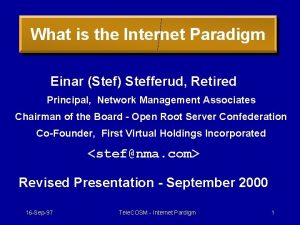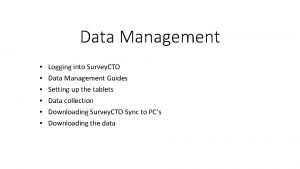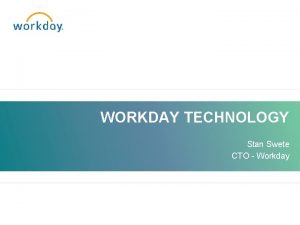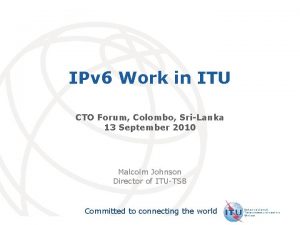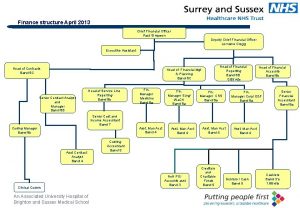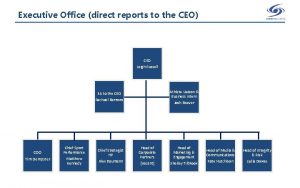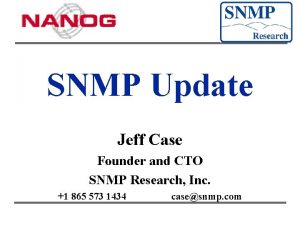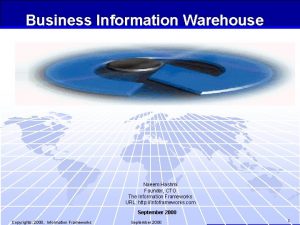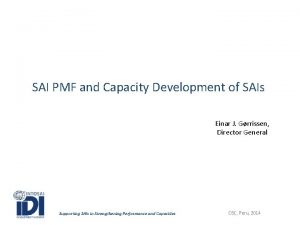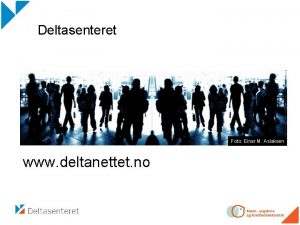Introduction Einar Aaland o o Founder and CTO



























- Slides: 27


Introduction § Einar Aaland o o Founder and CTO of SX Design Founded in 2000 Headquartered in Oslo, Norway Products • SIP SDK • Turnkey solutions (ATA, Phone, RGW) • x. APS client-server Automatic Provisioning System o o Qo. S and user-friendly focused solutions Professional Services

Qo. S intro § What is Qo. S? o The basic parameters of Qo. S are: • delay, jitter, bandwidth, packet loss, availability of service, compression o o Qo. S is an expression of a users experience with a service Two factors that lead to the product of Qo. S • information or tagging in the packets • mechanisms or algorithms in networking nodes or application o The end result of Qo. S is a combination of: • network setup, network availability, equipment mechanisms and application algorithms § What does Qo. S result in? o Satisfactory end-to-end user experience of the service § When are we satisfied? o o Good enough means satisfied and accepted Not good enough means NOT satisfied & NOT accepted No such things as ”almost satisfied” End User happiness is binary -> ON or OFF § How is Qo. S measured? o MOS – Mean Opinion Score - represents individual opinions of the experienced quality

Internet Service Usage Data 100% Streaming Yesterday’s Internet • Browsing • Email • File sharing • Radio Broadcast Today’s Internet • Yesterday ++ • Vo. IP • Gaming • AV Broadcast Tomorrow’s Internet • Today ++++ • Video Telephony • Video On Demand • Audio On Demand • Smart Networks

Internet ”Yesterday” § IP – the underlying fabric of the Internet o o Designed to provide best-effort system for delivery of data packets no guarantee of route, delay, sequence, packet loss or availability § Designed to run across virtually any network transmission media and system platform o radio, cable, Ethernet, UMTS, WLAN § IP networks utilizes all available bandwidth and provide high throughput o bandwidth sharing, consolidation and flexible routing § Nodes are intelligent o o o From node to node Self contained navigation (DNS, Proxy, DHCP) High flexibility and scalability IP networks were NOT designed for real-time / streaming

Internet ”Today” § We have moved from “IP over everything” to “everything over IP” o All types of communication is now using IP § Vo. IP was the first streaming application over IP o o Vo. IP got a bad name because of quality issues (even though we learned to accept it in the early days of GSM) Has driven the Qo. S evolution § Broadband is the fastest adopted technology ever o Vo. IP will leverage that momentum § Triple Play demand is currently exploding o Video, Voice, Data § Online gaming, Instant Messaging is growing super fast o The new generation is growing up – and they will soon be in power

Home Network Environment Kitchen Instant Messaging Home Office Vo. IP On-line Game P-P ports 100 Mbps 256 Kbps Uplink Congestio n Two or more applications or users sending data at the same time causes uplink congestion! Therefore a BAD user experience!

Internet “Tomorrow” § We are adapting our lives to include IP in everything we do • Dating • Chatting • Playing • Learning • Practicing • Talking • Viewing • Shopping • Working • Banking …including Virtual Quality-Time § PROBLEMS AHEAD! o Many new application with different requirements for: • Real-time • Bandwidth • Security o Must co-exist with each other AND together with ”bursty” data traffic • in networks that where not designed for Qo. S

The way people use Broadband at home is changing… § The use pattern o o From downstream to upstream From throughput to real-time § The users o From early adaptors to majority § Applications o Fighting for performance and Qo. S § The service providers o o o From data only to real-time service More and more wholesale over unknown networks Competing for loyalty

The usage change § Yesterday was about connection o o Downlink oriented Data oriented § Today we are adding real -time services o o o ”Today” Vo. IP, Video, Gaming Uplink bottleneck (with parasites using it even) § Tomorrow is all about multiple services o ”Yesterday” Content mix, user profiles and usage models Increasing bandwidth and quality requirements ”Tomorrow”

The Qo. S challenge § The key is to understand: o o o Networking end-to-end Users, usage and traffic patterns Applications requirements Application co-operation (or actually how they don’t) Content types, behavior and requirements: • Video On Demand • Video Broadcast • Video Telephony • Video Surveillance • Vo. IP o • Audio On Demand • Radio Broadcast • Gaming • Sensors and meters • VPN Data & file transfer, web browsing and emailing will keep use the Internet the same “peaky” way as before Make sure applications share the bandwidth and operate together in the best possible balance at any particular time

Application co-existence § It has taken 10 years to get Vo. IP to co-exist with all the data applications § Qo. S has been a challenge on the “best-effort” IP networks § Multiple new streaming applications are being introduced now § For applications to co-exist, services must be maintained at a satisfactory level § Bandwidth is not the answer, it will always be filled § Treating the content in the network bottlenecks is key

Content differences Streaming Latency? Jitter buffer? Direction Bandwidth Security Gaming Yes Instant No Up Low Vo. IP Yes Low No Both Low Medium V 2 o. IP Yes Low No Both High Medium Alarm Yes Medium Yes Both Low High Radio BC Yes Medium Yes Down Medium Low Video BC Yes Medium Yes Down High Low Metering Yes Long Yes Up Low Vid. Sur. Yes Long Yes Up Medium High Audio OD Yes Long Yes Down Medium High Video OD Yes Long Yes Down High Email No Very long Yes Both High Low Web No Very long Yes Down High Low * Content difference example

LAN <-> WAN traffic rate § LAN side of broadband modem running 10/100 Mb § WAN side is in most cases much lower rate (128 K to 1 M typically) § Modem has Rate Adjustment Buffer o o Introduces packet loss, jitter and delay No priority queuing present in RAB § Internet uplink is the biggest bottleneck today § Uplink tends to have unstable rate due to DSLAM overbooking by ISP’s

Rate adjustment - uplink LAN Increasing traffic Buffer increasing 10 Mb RAB Buffer overflow ”Peaky” LAN traffic WAN Rate adjusting in buffer 512 Kb Steady WAN traffic For data (TCP) traffic this utilizes uplink bandwidth to the maximum

Rate adjustment - streaming LAN Voice Packets Increasing traffic Peaks delay introduce Increasing jitter here 10 Mb RAB Buffer packet loss Fixed time interval Delay WAN 512 Kb Stream with packet Stream withloss, jitter increased jitter and delay When and Delay the Rate jitter Adjustment is introduced. Buffer in the(RAB) Rate Adjustment overflow, streaming Buffer (UDP) traffic will suffer. Data (TCP) traffic will re-transmit.

Solving Qo. S § Qo. S is not about best performance o it is all about best balance for the service at any particularly time § The key is to handle the content and the bottlenecks (usually the uplink) o must be handled dynamically • the usage changes (mom, dad, grandpa, sister have different priorities) • the DSLAM overbooking changes • applications will strive for best performance o operator must be able to tune and control Qo. S remotely on a per user basis at the lowest possible cost Ü SX Design x. APS architectured for that Best Qo. S does not exist for a service, but only for the user of that service! Multiple services must have dynamic adaption to best balance of services!

Qo. S we take for granted § Tagging o o To. S / Diff. Serv 802. 1 p/q Int. Serv VLAN § Application algoritms o o o GIPS Net. EQ Voice Activity Detection Comfort Noice Generation Accoustic/Line Echo Cancellation Adaptive Jitter Buffer Comression § Networking mechanisms o o o IP over ATM Virtual Connections RSVP . . . and many more. All this because we cannot handle the real-time sensitive traffic on best effort networks, where the concept is to share bandwidth and resources. The rest of this presentation is about how to do that!

Detecting content § An Integrated Access Device or Residential Gateway must serve all types of content § Detecting it dynamically and automatically is the key for further Qo. S mechanisms and handling § In order to handle content correctly, it must be classified for what it is, in order to know how to treat it

Packet fragmentation § Large packets that enters Rate Adjustment Buffers destroy Qo. S § If the uplink is narrow, extended packets will have huge impact o o Example: Transmitting one 9 k Ethernet frame (extended packet) on a 128 kbps uplink will take 70 ms 10 Mb access to this buffer from the LAN side will cause the buffer to quickly overflow -> packet loss and extreme delay § Short packets are much easier to prioritize § Packet fragmentation only when needed o only if real-time sensitive traffic is detected and only if the Rate Adjustment Buffer (RAB) is causing jitter/delay)

Priority queuing § Internet ”Tomorrow” will have many types of content and many types of services § Different requirements for content and services, and different user preferences § This will require high granularity for priority queuing o 2, 4, 6 or 8 levels is not enough § High granularity enables fine prioritization for best possible balance of content o 64, 128 or 256 levels

Traffic shaping § Dynamic adjustment to available bandwidth ahead o o Rate Adjustment Buffer DSLAM bandwidth (depending on overbooking rate and time a day) § Effectively taking the Rate Adjustment Buffer out of function o o No buffer overflow, packet loss, jitter Enables the use of the best codecs – no need to compress § Important part of Priority Queuing o Enables prioritization based on timing, rather than just order and counters

Result of propper handling No jitter and consistent flow No delay and packet loss Dynamic adaption based on content Dynamic adaption based on available bandwidth § Dynamic adaption based on origin § Always best codec § § o Compression doesn’t solve bottlenecks, proper handling enables use of best codecs

Qo. S handling gives results Before FTP transfers RAB effect Mean Opinion Score (MOS) 1 = Bad

Qo. S handling gives results After Consistent Throughput FTP transfers 4. 4 = PSTN Mean Opinion Score (MOS)

Qo. S needs on Automatic Provisioning System (APS) § Quality of Service starts at signup o installation, operation, maintenance § Quick settings when required and quick fixes when bugs are reported § Must be able to change rules and priorities for the dynamic Qo. S o Users have different priorities § System monitoring and syslog § Controlled rollout of new firmware o done group by group § Fault handling (recovery of service)

Summary § Qo. S is all about understanding content, its requirements and how to handle it § Qo. S is individual and applies for the person using the service § Qo. S must be adaptable and operator controlled § Qo. S is not about performance BUT the best possible balance
 Kenneth himma
Kenneth himma Knut einar rosendahl
Knut einar rosendahl Einar stef
Einar stef Einar meister
Einar meister Einar bergsholm
Einar bergsholm Einar h. valsson
Einar h. valsson Kompassi kasutamine
Kompassi kasutamine Jan einar barbo
Jan einar barbo Vertical
Vertical Gaia wire cto
Gaia wire cto Manuales cto
Manuales cto Cmo cto ceo
Cmo cto ceo Defense travel management office
Defense travel management office Cto survey
Cto survey Cto gpon
Cto gpon Stan swete workday
Stan swete workday Sfa cto
Sfa cto Miami j cto brace
Miami j cto brace Dts pos ack received
Dts pos ack received Cto
Cto Cto organizational chart
Cto organizational chart Cto sims
Cto sims Hybrid algorithm cto
Hybrid algorithm cto Apa itu cto
Apa itu cto Cto persona
Cto persona Cto
Cto Cto
Cto Barclays cto
Barclays cto


